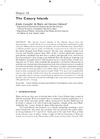Please use this identifier to cite or link to this item:
https://accedacris.ulpgc.es/handle/10553/73188
| DC Field | Value | Language |
|---|---|---|
| dc.contributor.author | Custodio, Emilio | en_US |
| dc.contributor.author | Cabrera Santana, María Del Carmen | en_US |
| dc.date.accessioned | 2020-06-10T13:04:04Z | - |
| dc.date.available | 2020-06-10T13:04:04Z | - |
| dc.date.issued | 2012 | en_US |
| dc.identifier.isbn | 9780203096123 | en_US |
| dc.identifier.other | Scopus | - |
| dc.identifier.uri | https://accedacris.ulpgc.es/handle/10553/73188 | - |
| dc.description.abstract | The volcanic Canary Islands, in the Atlantic Ocean, have the characteristics of small islands in an environment varying from sub-humid to arid, and quite different from one island to another and even within the same island. These conditions produce specific water availability circumstances to be solved in each of the islands, through island Water Councils. The two most important islands, Gran Canaria and Tenerife contain about 90% of the 2 million inhabitants. Intensive groundwater exploitation for more than a century, and especially in the last half century, has produced a deep change in groundwater flow, the drying up of springs and the depletion of aquifer reserves. This has given rise to a special culture of water winning and use. To solve water problems the progressive and decisive introduction of seawater and brackish water desalination has been a key element, and more recently of reclaimed wastewater, although gradually. This forms a complex system that includes private water markets and public water offers. About 50% of water is for irrigation, at prices that occasionally may reach or exceed 1 €/m3. The up to now unsustainable situation has had the benefit of allowing the economic and social development from an agriculture-based economy toward tourism and services. Currently it is evolving toward a more balanced economy but with high water costs and some environmental, although bearable, damage. | en_US |
| dc.language | eng | en_US |
| dc.publisher | Taylor & Francis Group | en_US |
| dc.publisher | Fundación Botín | en_US |
| dc.source | Water, Agriculture and the Environment in Spain: Can We Square the Circle? / Editores: Lucia De Stefano, M. Ramón Llamas. Capítulo 22, p. 281-289, (Enero 2012) | en_US |
| dc.subject | 250804 Aguas subterráneas | en_US |
| dc.subject.other | Canary Islands | en_US |
| dc.subject.other | Intensive Groundwater Development | en_US |
| dc.subject.other | Sustainability Issues | en_US |
| dc.subject.other | Water Cost | en_US |
| dc.subject.other | Water Markets | en_US |
| dc.title | The Canary Islands | en_US |
| dc.type | info:eu-repo/semantics/bookPart | en_US |
| dc.type | Book | en_US |
| dc.identifier.scopus | 85051715686 | - |
| dc.contributor.authorscopusid | 7004860144 | - |
| dc.contributor.authorscopusid | 35729991300 | - |
| dc.description.lastpage | 289 | en_US |
| dc.description.firstpage | 281 | en_US |
| dc.investigacion | Ciencias | en_US |
| dc.type2 | Capítulo de libro | en_US |
| dc.utils.revision | Sí | en_US |
| dc.date.coverdate | Enero 2012 | en_US |
| dc.identifier.ulpgc | Sí | es |
| dc.description.spiq | Q1 | |
| item.grantfulltext | open | - |
| item.fulltext | Con texto completo | - |
| crisitem.author.dept | GIR IUNAT: Geología de Terrenos Volcánicos | - |
| crisitem.author.dept | IU de Estudios Ambientales y Recursos Naturales | - |
| crisitem.author.dept | Departamento de Física | - |
| crisitem.author.orcid | 0000-0002-4556-4665 | - |
| crisitem.author.parentorg | IU de Estudios Ambientales y Recursos Naturales | - |
| crisitem.author.fullName | Cabrera Santana, María Del Carmen | - |
| Appears in Collections: | Capítulo de libro | |
SCOPUSTM
Citations
15
checked on Jun 8, 2025
Page view(s)
73
checked on Dec 28, 2024
Download(s)
92
checked on Dec 28, 2024
Google ScholarTM
Check
Altmetric
Share
Export metadata
Items in accedaCRIS are protected by copyright, with all rights reserved, unless otherwise indicated.
